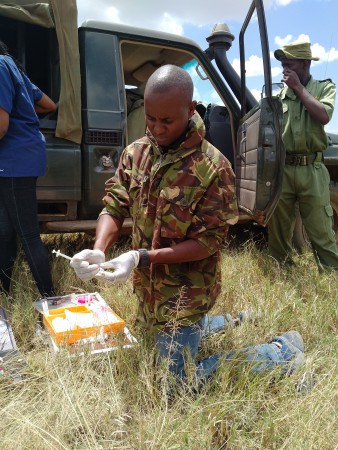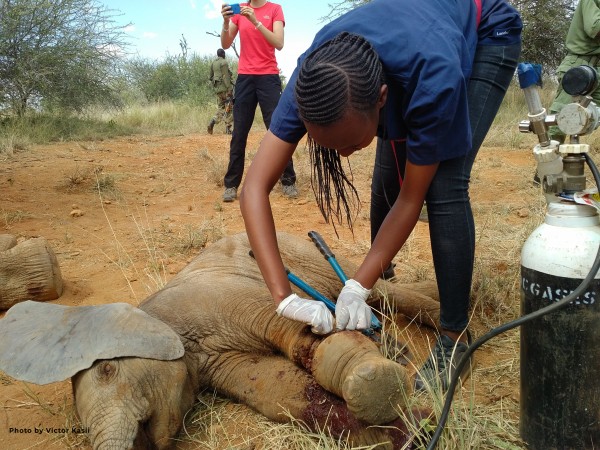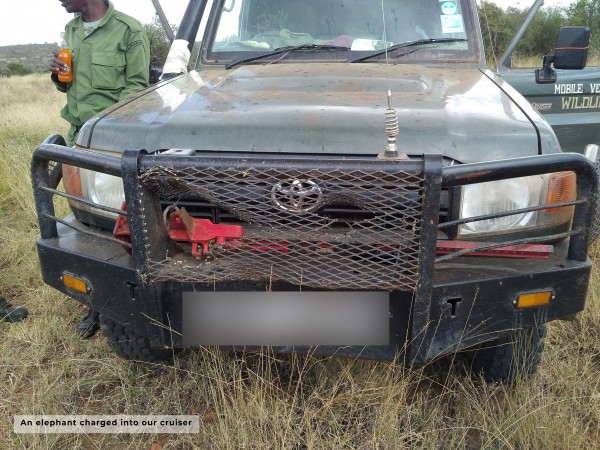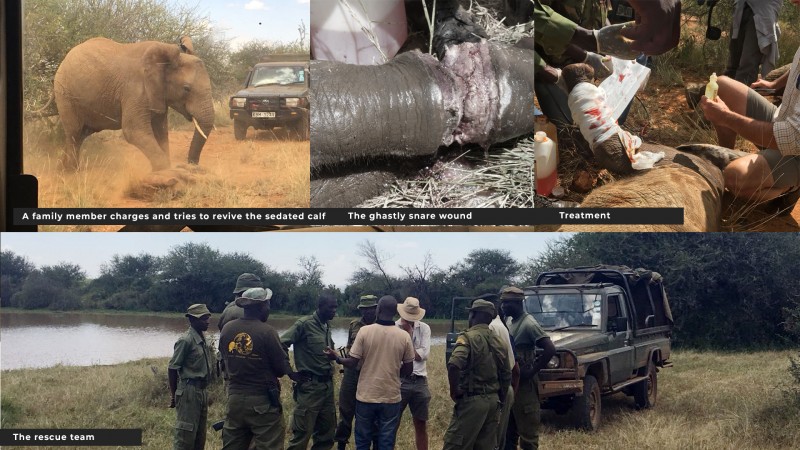Wednesday, 8th Aug, 4PM
Out and about at Mpala, the Living Laboratory and home of African wildlife on Explore, the Mpala Live team had trailed an elephant herd to a watering hole. In anticipation of World Elephant Day, celebrated every 12th day of August, we were in search of a good story to share with viewers on Explore.org. Sandy Oduor, an elephant researcher at Mpala, was our designated driver and guide, giving a live commentary while I filmed the elephant families that he easily identified. Sandy has been studying dynamics in elephant family structures for the last five years. Some of his work is captured in this video from 2014.
And then, alarmingly, our security officer pointed at a limping elephant calf. From the back of the Landcruiser, it was difficult to see the tiny animal as he was constantly lost in the herd’s legs. The larger animals took turns to cover the baby elephant as we moved around in a bid to investigate what the problem was. A brief opportunity presented and I managed to get a clear view. From the calf’s rear side, I filmed a few seconds of what looked like a ghastly snare that had cut into the animals front left ankle. Our search for an elephant story quickly turned into a rescue mission.
It is believed that the calf had inadvertently walked into a snare set up by bushmeat poachers. Away from protected areas like Mpala, snaring is a common method used by poachers to capture animals mainly targeted for their meat. Many of our elephant families have crossed over into Mpala in search of safe haven.
Thursday 9th August, 9AM
Dr. Matthew Mutinda of the Kenya Wild Life Service (KWS) together with Dr. Maureen Kamau, the resident Smithsonian veterinary fellow at Mpala, were on site to treat the young animal. A team of six rangers under Mpala’s security manager, Julius Nakolonyo, led the rescue mission. David Hewett, Mpala’s ranch manager, was at hand to oversee the entire operation.The operation would not have been successful on the evening of the previous day as darkness engulfed us soon after discovering the injured baby elephant.
After assessing the situation, Dr. Mutinda determined that both the mother and calf needed to be immobilized while the rangers scared away the rest of the family. The vets prepared doses, medicines and then, an adrenaline-charged encounter to sedate and safely separate the calf from the herd began.
What sounded like a straightforward plan took nearly four hours to execute with the actual treatment taking only eight minutes! As our four Landcruisers herded the elephants towards a clearing, the calf was constantly covered on all sides by the family. The herd tested our rangers training, patience, and skills. Elephants display complex social and emotional behaviour and value their families. Families have a matriarchal head, an older, experienced female elephant that leads the herd. A family usually consists of a mother, her sisters, daughters and their calves. In this case, the whole family was protecting the lone calf. At one point the rangers fired a few shots in the air to disperse the marauding and charging elephants.
Doctors Maureen and Mutinda hovered over the calf, first inspecting the extent of the damage to the foot. The Rangers maintained a perimeter, strategically positioned to keep the rest of the herd away. All the engines in the cruisers were running, doors open in case we needed to jump in and save ourselves. I could see David help the KWS ranger lift an oxygen tank off the back of the vet car. With the calf on oxygen and stabilized, Dr. Maureen got a hold of a heavy gauge wire cutter and went on to remove the snare while Dr. Mutinda checked on the mother.
Five minutes into the operation, the calf had been cleaned up, antibiotics and painkillers administered, bandaged up and blood samples extracted from both the mother and baby. “They will be awake in three minutes. Everyone, pack up and get ready to board. All drivers, get behind your wheels!” Dr. Mutinda shouted over the running engines.
The calf stood up first and went straight to nurse from the mother who was quickly coming to. By then, we were all safe in our cars, some distance away from the animals because as soon as the mother stood up, the entire herd ran back to rejoin her and the calf.
“We determined that the damage is extensive but remain hopeful that she will recover. The Rangers will keep monitoring the situation, the bandage should wear off in a few days but we will definitely check on this animal in two weeks.” Dr. Mutinda concluded.
Happy World Elephant Day!
Peace,
Victor Kasii @mpalalive








